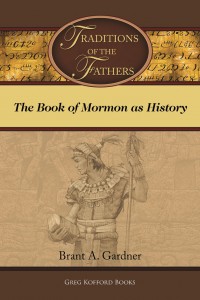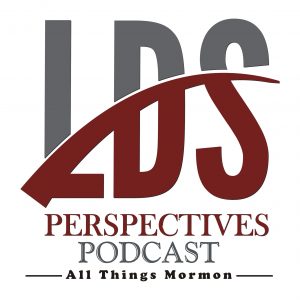
Brant A. Gardner won the 2015 AML Award for Religious Non-Fiction for Traditions of the Fathers: The Book of Mormon as History (Greg Kofford Books). Laura Harris Hales recently interviewed Gardner for an upcoming episode of the LDS Perspectives Podcast, which will debut Sept. 22. While the podcast episode will focus on the content of Gardner’s work, she also asked a few questions about his style and writing process, to be used here at the AML blog. Here is a selection of their conversation, edited slightly for print.
LHH: You won Best Religious Non-Fiction book for 2015, well deserved, I must say. They had three questions for you as an author. First, how would you describe your style of writing?
 BG: That is very hard to answer, because I am not sure how to describe it, other than to describe the kinds of things I’m trying to do as an author. I’m trying to write for later high school/college age. As for my style, I tend to let my sources speak more directly than a lot of people do, with a lot more quotations. Modern style wants to hide [quotations] in the text, or put all of the quotations in the footnotes, while I bring them out. There is controversial enough information that I don’t want to hide my work. I want people to know what the sources are, and know the reason why I am drawing that particular conclusion. There is enough reason for people to wonder about these topics, they shouldn’t wonder about how I have interpreted the data I am using. So that is one difference in how I approach things.
BG: That is very hard to answer, because I am not sure how to describe it, other than to describe the kinds of things I’m trying to do as an author. I’m trying to write for later high school/college age. As for my style, I tend to let my sources speak more directly than a lot of people do, with a lot more quotations. Modern style wants to hide [quotations] in the text, or put all of the quotations in the footnotes, while I bring them out. There is controversial enough information that I don’t want to hide my work. I want people to know what the sources are, and know the reason why I am drawing that particular conclusion. There is enough reason for people to wonder about these topics, they shouldn’t wonder about how I have interpreted the data I am using. So that is one difference in how I approach things.
LHH: They call that [style of writing] popular non-fiction. It drives me crazy, because not only is it very difficult to find the source, they [also simply] use sentences in the back to identify the quote. I think it is squishy scholarship. You just have to take it on trust.
BG: And that is the problem. [It would be good if] we were able to take on trust that authors are using their sources correctly. Unfortunately, I happen to know a lot of people who write on the Book of Mormon who have not done that, and I need to see the sources to know how they happen. I’ll give you a quick example. L. Taylor Hansen wrote a book, He Walked the Americas (1963). I see it passed around a lot as a really good example of how native tales talked about the white. And so I have read the book, and frustratingly she has no footnotes, so you have no idea where she is getting these things. But, when she is talking about Quetzalcoatl, I know the sources, and so I know what she read, and I can tell how she interpreted the information. I don’t agree with her, and the sources don’t say what she says what they said. I don’t want people doing that with my work. I want them to know exactly what the source was, to be able to say, “Okay, that is a reasonable explanation based on that information.”

LHH: When I pick up a book by Brant Gardner, I know that I am reading Brant Gardner’s analysis. But I want to know when your analysis starts, and someone else’s stops. That is why I appreciate good footnoting.
What kind of method do you use while you are writing? Do you gather all of your materials first, and then sit down and put it all together? Or do you put it together in chunks at a time?
BG: I think I do things in chunks. It will depend on the book . . . and what I am reading at any given time. When I am starting to put it together, gaps will pop up, and I will say, oh shoot, I need to know more about this, then go off and do some research.
LHH: Some people write the first chapter last. How about you?
BG: I don’t even know what the first chapter is . . . I have been known to write an introduction three or four times, and then figure out that it should have been a preface instead. I am absolutely infamous for writing the first page of anything at least six times. I have gone to my wife and said, “I have been writing all morning, I have made some progress. I am up to a page and a half of text, and I have only thrown four pages away.”
LHH: That is actually quite a good ratio.
BG: (Laughs) Good to know!
LHH: You know the quote from Hemingway, he said if you could save one sentence a day, he felt it had been a good day. As an editor, I love to hear that you are revising five or six times, because that is how great literature is written. Finally, what are your goals as a non-fiction writer?
 BG: I am looking to help people understand a text. We understand the [Book of Mormon] text in a modern context as a piece of sacred literature. We interact with it that way, and that is perfectly fine, we don’t have to know anything about history. But, it is a text that says that it has history. It is a text that proclaims that there are people in the past who generated it. I want to understand those people, put flesh on the bones, I want to understand what their motivations were [for their actions. For example] the Anti-Nephi-Lehis, when it said that they buried their weapons of war. I want to know why they buried them, why didn’t they take them to the pawn shop? Why did those people say, “You know, I really can’t fight, I’d like to defend you, but I can’t. But I have a 12-year old son, he could go off to war, that would be fine.” I want to know why. I think that understanding the human side of things helps us understand the text better. That is what I am shooting for.
BG: I am looking to help people understand a text. We understand the [Book of Mormon] text in a modern context as a piece of sacred literature. We interact with it that way, and that is perfectly fine, we don’t have to know anything about history. But, it is a text that says that it has history. It is a text that proclaims that there are people in the past who generated it. I want to understand those people, put flesh on the bones, I want to understand what their motivations were [for their actions. For example] the Anti-Nephi-Lehis, when it said that they buried their weapons of war. I want to know why they buried them, why didn’t they take them to the pawn shop? Why did those people say, “You know, I really can’t fight, I’d like to defend you, but I can’t. But I have a 12-year old son, he could go off to war, that would be fine.” I want to know why. I think that understanding the human side of things helps us understand the text better. That is what I am shooting for.
Thank you Laura and Brant. Here is the text of Brant’s award citation.
This outstanding contribution synthesizes cutting edge Book of Mormon scholarship in a compelling addition to the discussion on Book of Mormon historicity. Himself a seasoned scholar of the Book of Mormon, Gardner adds depth and nuance to the intricacies surrounding Book of Mormon historicity and provides both laypersons and scholars alike with an excellent resource on this topic. With the Book of Mormon receiving increased scholarly attention both inside and outside of Mormon circles, including scholarly investigations into the narrative, theology, reception history, and transmission of the text, Traditions of the Fathers should rightfully take center place in the discussion on the book’s historicity.
Gardner convincingly argues that the Book of Mormon can be taken seriously as an ancient record. His fruitful methodology of seeking “convergences” (not “proofs”) between the text and the archaeological record is illuminating. Whether it is geographical, cultural, or linguistic convergences with the ancient Near East or pre-Columbian Mesoamerica, Gardner has marshaled a substantive body of correlations between the Book of Mormon and the ancient world that should raise important questions for readers of the text on all sides of the debate. For these and other reasons, Traditions of the Fathers is essential reading for any student of the Book of Mormon, and is this year’s winner of the Religious Non-Fiction Award.

Awesome.
I admit, I write a book straight through. I’m kind of a linear thinker.
I agree that revisions is where writing goes from iffy to wonderful.
And I want to read your book now.